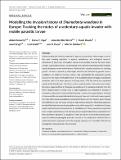Files in this item
Modelling the invasion history of Sinanodonta woodiana in Europe : tracking the routes of a sedentary aquatic invader with mobile parasitic larvae
Item metadata
| dc.contributor.author | Konečný, Adam | |
| dc.contributor.author | Popa, Oana | |
| dc.contributor.author | Bartáková, Veronika | |
| dc.contributor.author | Douda, Karel | |
| dc.contributor.author | Bryja, Josef | |
| dc.contributor.author | Smith, Carl Hendrik | |
| dc.contributor.author | Popa, Luis | |
| dc.contributor.author | Reichard, Martin | |
| dc.date.accessioned | 2018-10-24T10:30:07Z | |
| dc.date.available | 2018-10-24T10:30:07Z | |
| dc.date.issued | 2018-12 | |
| dc.identifier | 255399515 | |
| dc.identifier | 3a8835fe-dad3-47af-a8f0-e554497867df | |
| dc.identifier | 85055271494 | |
| dc.identifier | 000449942900015 | |
| dc.identifier.citation | Konečný , A , Popa , O , Bartáková , V , Douda , K , Bryja , J , Smith , C H , Popa , L & Reichard , M 2018 , ' Modelling the invasion history of Sinanodonta woodiana in Europe : tracking the routes of a sedentary aquatic invader with mobile parasitic larvae ' , Evolutionary Applications , vol. 11 , no. 10 , pp. 1975-1989 . https://doi.org/10.1111/eva.12700 | en |
| dc.identifier.issn | 1752-4571 | |
| dc.identifier.other | ORCID: /0000-0003-3285-0379/work/47531660 | |
| dc.identifier.uri | https://hdl.handle.net/10023/16310 | |
| dc.description | Funding: Grantová Agentura České Republiky (GrantNumber(s): 13-05872S) Romanian Ministry of Education (GrantNumber(s): CNCS UEFISCDI PN II-RU-PD-2012-3-0479). | en |
| dc.description.abstract | Understanding the invasive potential of species outside their native range is one of the most pressing questions in applied evolutionary and ecological research. Admixture of genotypes of invasive species from multiple sources has been implicated in successful invasions, by generating novel genetic combinations that facilitate rapid adaptation to new environments. Alternatively, adaptive evolution on standing genetic variation, exposed by phenotypic plasticity and selected by genetic accommodation, can facilitate invasion success. We investigated the population genetic structure of an Asian freshwater mussel with a parasitic dispersal stage, Sinanodonta woodiana, that has been present in Europe since 1979 but which has expanded rapidly in the last decade. Data from a mitochondrial marker and nuclear microsatellites have suggested that all European populations of S. woodiana originate from the River Yangtze basin in China. Only a single haplotype was detected in Europe, in contrast to substantial mitochondrial diversity in native Asian populations. Analysis of microsatellite markers indicated intensive gene flow and confirmed a lower genetic diversity of European populations compared to those from the Yangtze basin, though that difference was not large. Using an Approximate Bayesian Modelling approach, we identified two areas as the probable source of the spread of S. woodiana in Europe, which matched historical records for its establishment. Their populations originated from a single colonization event. Our data do not support alternative explanations for the rapid recent spread of S. woodiana; recent arrival of a novel (cold‐tolerant) genotype or continuous propagule pressure. Instead, in situ adaptation, facilitated by repeated admixture, appears to drive the ongoing expansion of S. woodiana. We discuss management consequences of our results. | |
| dc.format.extent | 15 | |
| dc.format.extent | 1383865 | |
| dc.language.iso | eng | |
| dc.relation.ispartof | Evolutionary Applications | en |
| dc.subject | Anodonta woodiana | en |
| dc.subject | Approximate Bayesian computation | en |
| dc.subject | Biological invasion | en |
| dc.subject | Introduction history | en |
| dc.subject | Invasion genetics | en |
| dc.subject | Population genetics | en |
| dc.subject | Unionid mussel | en |
| dc.subject | QH301 Biology | en |
| dc.subject | QH426 Genetics | en |
| dc.subject | DAS | en |
| dc.subject | SDG 15 - Life on Land | en |
| dc.subject.lcc | QH301 | en |
| dc.subject.lcc | QH426 | en |
| dc.title | Modelling the invasion history of Sinanodonta woodiana in Europe : tracking the routes of a sedentary aquatic invader with mobile parasitic larvae | en |
| dc.type | Journal article | en |
| dc.contributor.institution | University of St Andrews. School of Biology | en |
| dc.contributor.institution | University of St Andrews. Marine Alliance for Science & Technology Scotland | en |
| dc.contributor.institution | University of St Andrews. Scottish Oceans Institute | en |
| dc.identifier.doi | https://doi.org/10.1111/eva.12700 | |
| dc.description.status | Peer reviewed | en |
This item appears in the following Collection(s)
Items in the St Andrews Research Repository are protected by copyright, with all rights reserved, unless otherwise indicated.

